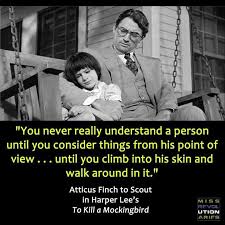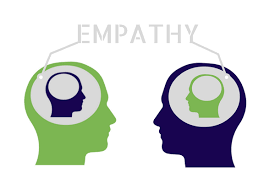
Many of you would have read Harper Lee’s “To kill a mocking bird” or watched the movie starring the very handsome Gregory Peck. This book is a classic on Empathy and I would recommend everyone pick it up to understand the true meaning of Empathy.
What is Empathy?
“Empathy is like a universal solvent. Any problem immersed in empathy becomes soluble” -Simon Baron-Cohen, British clinical psychologist, and professor of developmental psychopathology, University of Cambridge, in his book “Zero degrees of Empathy: A new theory of human cruelty”
In its simplest form, empathy is the ability to recognize emotions in others, and to understand other people’s perspectives on a situation. At its most developed, empathy enables you to use that insight to improve someone else’s mood and to support them through challenging situations.
How is Empathy different from Sympathy?
Empathy is often confused with sympathy, but they are not the same thing. Sympathy is a feeling of concern for someone, and a sense that they could be happier. Unlike empathy, sympathy doesn’t involve shared perspective or emotions.
Empathy and Emotional Intelligence
According to psychologist Daniel Goleman, empathy is one of the five key components of emotional intelligence – a vital leadership skill. The five components are
- Self-awareness.
- Self-regulation.
- Motivation.
- Empathy.
- Social skills.
I’m not going into the details of Emotional Intelligence here. That’s for another time. But suffice is to say that in order to be a successful leader one needs to be empathetic to one’s subordinates and team members.
Empathy is developed through 3 stages.
- Cognitive Empathy: It is the ability to understand what another person might be thinking or feeling. It need not involve any emotional engagement by the observer. Managers may find cognitive empathy useful in understanding how their team members are feeling, and therefore what style of leadership would get the best from them today. Similarly, sales executives can use it to gauge the mood of a customer, helping them to choose the most effective tone for a conversation.
- Emotional Empathy: It is the ability to share the feelings of another person, and so to understand that person on a deeper level. It helps to build trust between managers and team members, and to develop honesty and openness.
- Compassionate Empathy: It is the most active form of empathy. It involves not only having concern for another person, and sharing their emotional pain, but also taking practical steps to reduce it.
Exercising Empathy
According to Stanford Psychologist Jamil Zaki empathy is like a muscle — it can be strengthened with exercise and it can atrophy when idle. So how does one “exercise” Empathy? Prof Zaki writes in Harvard Business Review that the first step towards building empathy is acknowledging that it is something that can be built.

Minter Dial in his book “Heartificial Empathy” lists out the following five activities for flexing empathy muscle.
- Listen actively Practice active listening by reformulating the message to the person who just said it. Observe the nonverbal cues. The key is to focus on the intended meaning and feelings of the person you are interacting with. Use your ears, eyes and “gut instincts” to understand the entire message that they’re communicating. Start with listening out for the key words and phrases that they use, particularly if they use them repeatedly. Then think about how as well as what they’re saying. What’s their tone or body language telling you? Are they angry, ashamed or scared, for example? Take this a stage further by listening empathetically. Avoid asking direct questions, arguing with what is being said, or disputing facts at this stage. And be flexible – prepare for the conversation to change direction as the other person’s thoughts and feelings also change.
- Explore differences. Put yourself in environments where people are from different backgrounds. For example, you might want to join a local community outreach group or volunteer for some charity work. It is one of the best ways to learn from the diversity of others’ experiences.
- Read fiction. According to Prof Zaki, “There’s a fair amount of evidence now that the more fiction that people read, the more empathetic that they become, because fiction is one of the most powerful ways to connect with people who are different from us who we might not have a chance to meet otherwise.” Fiction apparently tricks our minds into thinking we are part of the story, and the empathy we feel for characters wires our brains to have the same sensitivity towards real people. If Obama, Bill Gates and Sheryl Sandberg can make time for reading fiction, why can’t you?
- Practise mindfulness. Mindfulness and meditation are all about focusing on the here and now. And one certainly needs to be “present” when listening to someone else in order to empathise with them.
- Remember why. If you know why you need to be more empathetic, you will create the environment, set aside the time and make the effort. So create the necessary awareness within yourself.
In addition to the above, I would like to add the following if you aim to be an empathetic leader.
- Consider other people’s perspective/be non-judgmental. Keep an open mind. Placing too much emphasis on your own assumptions and beliefs doesn’t leave much space for empathy! Even when the feelings of others are directly opposite to yours, don’t judge. Let go of your biases and be open to new perspectives. Look at it as an opportunity to better understand what they’re experiencing and expressing.
- Encourage the quiet ones. Make it a point to encourage people to have a say. The simple act of encouraging the quiet ones will empower everyone around you.
- Take a personal interest. Show genuine curiosity about the lives of those who work with you, show your interest by asking questions about their lives, their challenges, their families, their aspirations. Showing personal interest without sounding intrusive is the strongest way to build relationships.

Ref: Minter Dial, Heartificial Empathy: Putting Heart into Business and Artificial Intelligence
Hidden Brain. You 2.0: The Empathy Gym.NPR.org
HBR, Emotional Intelligence: Making Empathy Central to your Company Culture by Jamil Zaki, May 30 2019
* For Training,Workshop, Counseling and Coaching please connect with us at 9818105631 or mail us at training@samunnati.org